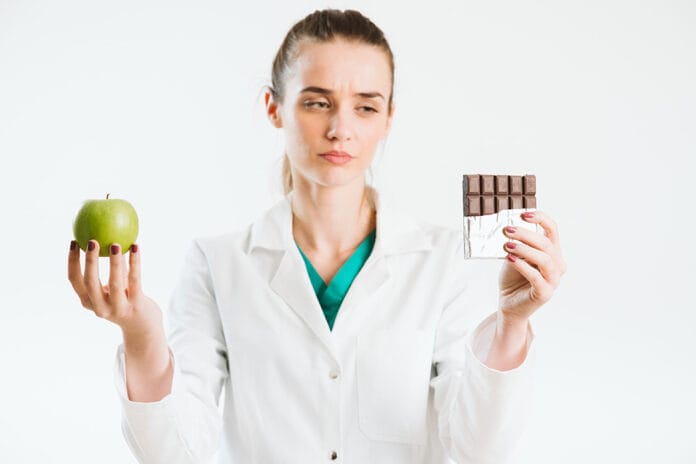Have any dental patients stated that they want to eat better, but “I just don’t know where to start,” and if so, what did you tell them? Do you, as a dental hygienist, even know where to start?
What does it take to form a new habit? After all, new beginnings aren’t anything new. As a matter of fact, many people start anew on New Year’s Day, but by the end of the month, old habits have resumed. Every day is a perfect day to form a better habit.
What Do You Know?
Dental hygienists are great at taking care of patients. We listen to the excuses, problems, and challenges. We show empathy and compassion about life and dental concerns, but how many of us know how to guide our patients to better nutrition?
When I was in hygiene school, I had one semester of nutrition, and I studied the different aspects of carbohydrates, fats, and proteins. I knew there was more information to be learned. It’s taken me more years than I’d like to admit to finally be confident in having a conversation about food and nutrition. The truth is, most of us know way more about nutrition than our patients.
Like dental hygiene, nutrition is a science too. There’s always something new emerging, such as new trends in diets that often have an effect on oral health. The ketogenic diet, for example, puts the body in ketosis. The result is often xerostomia and halitosis due to acetone release.1 While halitosis is not an oral “disease” in and of itself, it is a negative side effect of this particular diet. Xerostomia, however, is a negative oral condition to consider when talking with patients about the foods they eat or the diets they are on.
We’ve seen the patient who seemingly does all the necessary steps with brushing and interdental cleaning. We know this because there is virtually no plaque or calculus present. Yet, as soon as we start scaling, the bleeding is so heavy that we wonder if a transfusion will be necessary. In a pilot study, participants were placed on an optimized diet for four weeks. The diet advocated foods low in carbohydrates, rich in Omega 3 fatty acids and rich in vitamins C and D, antioxidants, and fiber for four weeks. The control group did not change their dietary behavior. The results showed that despite constant plaque values in both groups, and all inflammatory parameters decreased to half of the baseline values in the experimental group.2
Food as Medicine
In the West, we think of medicine as prescriptions, over-the-counter medications, and/or supplements. I would like to offer another idea: Think of food as medicine. What is consumed is absorbed into the body, creating either health or disease.
As we age, cellular turnover slows down. Cells are the basic building blocks of tissues, and all cells change with the aging process. As aging continues, waste products build up in the tissues. Connective tissues change, becoming stiffer. This affects the organs, blood vessels, and even makes the airway more rigid.2 Feeding our body what it needs for health will allow our cells to be stronger too.
Bio-individualism is the idea that there is not a one-size-fits-all approach to health and nutrition. Rather, the concept is that we are all unique in our genetic makeup and our response to environmental factors. Because each person is a bio-individual, it’s important to listen to the patient. How do they feed themselves? Do they cook, or is there someone else in the home that does? What small steps are they willing to take today?
Dietary theories that work for one person may not work for another. Foods that are consumed by some may be nutritive, while to others may be like taking a poison. For example, suggesting dairy to meet the USDA requirement of calcium to someone who is dairy sensitive will have negative side effects. Their body will see that particular food as a toxin creating a series of problems. Gluten is another food that could be toxic if there is a sensitivity.
While it’s not necessary to know and understand all the dietary theories, it’s important to understand the premise of nutrition and how the foods we eat affect oral health. However, there are ways to gain knowledge about nutrition. I enrolled in a year-long program to be a health coach, took a program from e-Cornell University on plant-based diets, and read a number of books of interest. Quality continuing education courses are available as well.
Inflammation in the body shows up as inflammation in the mouth, which can be directly related to the foods consumed.3 Another key component is how stress directly affects food choices. In the United States, cardiovascular disease, cancer, and diabetes collectively account for nearly 70% of all deaths. These diseases share inflammation as a common link. Dietary choices clearly influence inflammation according to both prospective observation studies as well as randomized controlled trials.4
Change is Hard
My patient, during one appointment, seemed to be at a loss as to what to do to change her current situation. Her current routine did not leave room for both grocery shopping and cooking. Eating breakfast on the way to work, going to the drive-through at lunch, and consuming packaged food for supper was her usual lifestyle choice. I can certainly understand why she had reported she didn’t feel well. Her gingiva didn’t feel well either, and she presented with moderate gingivitis even though she was performing her oral hygiene diligently.
How can a dental hygienist offer counseling for our patients who clearly need help? One option is to offer an appointment for just that, nutritional counseling. Typically, there is not enough time in a regular hygiene appointment to engage in a thorough history of nutrition and lifestyle for each patient. Generally, insurance companies will not pay for nutritional counseling. However, it is a necessary part of the preventive program we have to offer. Why not give our patients the option? You may be surprised by their answers.
I know one dental hygienist who meets with her periodontal patients for a nutritional counseling appointment before she schedules them for non-surgical periodontal therapy. Nutrition is an important component in healing, and, to get the best results possible, patients can benefit from our knowledge and encouragement. While I weave information about nutrition into my appointments, I typically offer to meet with them as a health coach outside of the practice.
Dental hygienists have a wide-angle view of the whole patient, and we have access to their health history and have a pulse on their oral health. We are perfectly positioned to treat the whole person, and I believe it begins with nutrition and lifestyle choices. Meeting weekly or bi-monthly while holding the patient accountable will be more successful than seeing them every six months.
Routines vs. Habits
Most people, including me, assumed routines and habits were interchangeable, but they are not. A habit is a behavior that is done with little to no thought, while a routine involves a series of repeated behaviors with intentions. In time, a routine can become a habit.5
Routines can be uncomfortable at first and take a concerted effort. On the other hand, habits come with ease, such as brushing teeth or having that morning cup of coffee.
Some experts assert that it takes 21 days to create a new habit. If that were the case, how come we all aren’t still going to the gym and eating kale in March? The amount of time it takes to create a new habit will vary from person to person. Of course, the more difficult the routine, the longer it will take before it becomes a habit. Eating fast food is easy, but preparing food ahead of time will take more effort.
In the End
At the end of the appointment with my patient, she had decided she could make a smoothie in the morning to consume on her way to work. While that isn’t my first choice for her because many smoothies contain added sugar, it is at least a start. It’s important to meet our patients where they are.
She also thought she could make time over the weekend to do some food prepping for the week ahead. Making changes requires a huge effort, and only the patient can decide for themselves if they are ready to do it.
A week after her appointment with me, I reached out, asking if and how I could help her further. As of the writing of this article, I have had no response from her. I’m choosing to believe a seed was planted during that appointment time, and even though she may not be ready to make the change yet, perhaps one day she will.
Over the years, I’ve witnessed seeds sprout and grow. One patient, in particular, has severe periodontal disease yet refuses to see a periodontist. Over the years, I’ve explained inflammation and sugar’s role in that process. During one appointment, which I will never forget, I asked her what had changed. Her tissues were healthier, and pocket depths were decreased.
At first, she said nothing had changed as she was still using her electric toothbrush and oral irrigator. After a few moments, she then told me she had stopped eating sugar two months prior. Wow, I couldn’t believe the difference in her oral health! She said she had read a book about quitting sugar and decided to give it a try. She was very pleased to know the positive effect it was having on her oral health.
I encourage you to start the conversation with your patients by asking open-ended questions in order to get a pulse on where they are in the nutritional sense. From there, you can begin to ascertain their routines. It only takes a small change to create a huge ripple effect, and perhaps you can be that change for your patient.
Now Check Out the Peer-Reviewed, Self-Study CE Courses from Today’s RDH!
Listen to the Today’s RDH Dental Hygiene Podcast Below:
References
- Devkota, B.P. (2021, November 3). Ketones: Reference Range, Interpretation, Collection, and Panels. https://emedicine.medscape.com/article/2087982-overview
- Woelber, J., Bremer, K., Vach, K. et al. An Oral Health Optimized Diet Can Reduce Gingival and Periodontal Inflammation in Humans—A Randomized Controlled Pilot Study. BMC Oral Health. 2017; 17(28). DOI: 10.1186/s12903-016.0257-1. https://bmcoralhealth.biomedcentral.com/articles/10.1186/s12903-016-0257-1
- Aging Changes in Organs, Tissues, and Cells. (n.d.). National Library of Medicine. https://medlineplus.gov/ency/article/004012.htm.
- Konkel, J., Boyle, C., Sishnan, S. Distal Consequences of Oral Inflammation. National Library of Medicine. 2019; 10: 1403. DOI: 10.3389/fimmu.2019.01403. https://www.ncbi.nlm.nih.gov/pmc/articles/PMC6603141/
- Kiecolt-Glaser, J. Stress, Food, and Inflammation: Psychoneuroimmunology and Nutrition at the Cutting Edge. National Library of Medicine. 2010; 72(4): 365-369. DOI: 1097/PSY.0b013e3181dbf489. https://www.ncbi.nlm.nih.gov/pmc/articles/PMC2868080/
- DePaul, K. (2021, February 2). What Does It Really Take to Build a New Habit? Ascend. https://hbr.org/2021/02/what-does-it-really-take-to-build-a-new-habit.















